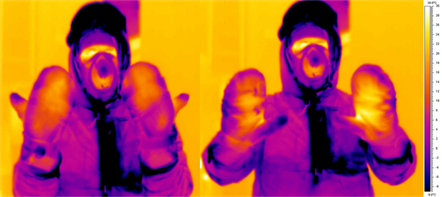On 31st August 2011 a team convened at Cold Chamber ENV9 at Millbrook Proving Grounds in Bedfordshire with two intense days ahead of them. Their aim was to select and test clothing options for the Antarctic crossing.
Where were we?
 Millbrook Proving Grounds is a vehicle testing facility near Bedford which runs just about every type of vehicle test you could imagine for both the civilian and military sectors. You will probably have seen it on TV as it is regularly used by a host of motoring programmes, including BBC’s Top Gear.
Millbrook Proving Grounds is a vehicle testing facility near Bedford which runs just about every type of vehicle test you could imagine for both the civilian and military sectors. You will probably have seen it on TV as it is regularly used by a host of motoring programmes, including BBC’s Top Gear.
Millbrook has a series of different-sized environmental chambers to recreate a very broad range of environmental conditions and we werig enough for all of our tests and could get down to -55C.
What was the plan?
There is a myriad of formal test specifications that could be used for assessing the performance of individual items of clothing. However, to use such a formal approach would have tied up laboratory facilities for weeks and we didn’t have the time or the budget. We were also testing equipment for use only at the most extreme end of the scale, so our own personal assessment, trialling equipment side by side, was our best way forward. The outcome of our chamber testing would be a recommendation on what to take for field testing in the Arctic winter in Sweden earlier in 2012. The Arctic would be the more formal qualification, this was the sifting of different technologies and designs.
The tests were a combination of wearer trials, which provided crucial opinions on comfort, dryness, ability to function etc, and isolated equipment trials, in which the human is deliberately taken out of the equation and the results are in the measured data.
(Note: We will not use this website to present specific results on different makes of clothing as this would be unfair to the manufacturers who were kind enough to offer equipment. Our tests were very much geared around the expedition’s specific needs and do not necessarily reflect how the equipment works in more normal circumstances.)
Isolated Equipment Testing
Down Jackets
These high value and complex items are hard to compare as they would never be worn without a variety of layers underneath, which all contribute to the overall effect for the wearer. To assess the jackets in isolation we needed a surrogate torso of suitable mass and predictable cooling behaviour.
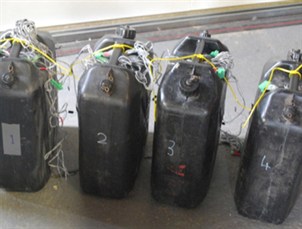 For our surrogates, we used 40-litre jerrycans filled with water warmed to the temperature of the human body. These would be suspended from a rail so that there was no obvious heat conduction path. Geoff Long attached thermocouples to the front and rear faces of each to record the ‘skin’ temperature. Each water container was then fitted with a jacket, their bottom draw cords pulled tight and the hoods pulled over so that they completely shielded the jackets in the same manner as each other.
For our surrogates, we used 40-litre jerrycans filled with water warmed to the temperature of the human body. These would be suspended from a rail so that there was no obvious heat conduction path. Geoff Long attached thermocouples to the front and rear faces of each to record the ‘skin’ temperature. Each water container was then fitted with a jacket, their bottom draw cords pulled tight and the hoods pulled over so that they completely shielded the jackets in the same manner as each other.
The thermocouples were attached to a data logger and the cooling recorded. This was our first test and whilst underway we were able to sort through the mountain of gear we had prepared for the first wearer trials.
It was most pleasing to find that even with the chamber at an average -53C, which was further enhanced by a significant draft caused by the chamber’s own fans and a large blower to maximise the effect, all the jackets performed very well – indeed, the experiment went on significantly longer than anticipated. There was an average drop of ‘skin’ temperature of just 4C in the first two hours. The jackets may be expensive, but they certainly work!
Boots
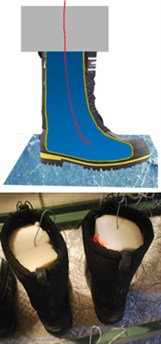 We had three high performance models to test and each was tested with and without electrically-powered heated insoles. We felt that the testing of these in isolation was very important as the perception of warmth from a heated insole could be quite different from what it was actually achieving.
We had three high performance models to test and each was tested with and without electrically-powered heated insoles. We felt that the testing of these in isolation was very important as the perception of warmth from a heated insole could be quite different from what it was actually achieving.
Following the principles used in the isolated jacket tests we used shaped sealed bag of water at body temperature as our surrogate lower limb and inserted a pair of thermocouples well down into the body of water. We avoided contact between thermocouple and the skin of the bag so that we weren’t recording conduction at this surface. The boots were placed on the steel chamber floor, which was very conductive and a good match for an ice-shelf. A foam block was then inserted into the top of the boot to control and minimise heat loss up and out of the boot.
For each pair of boots one insole was powered up just before the test started, the other left off.
The graph below represents the results from these tests. The top two lines are the heated versions of the next two down, which clearly indicates that the powered insoles do provide a benefit in reducing the rate of heat of loss, rather than preventing it.
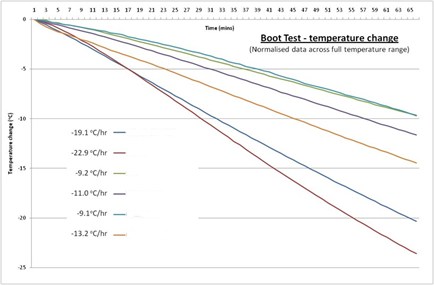
Gloves
To test the passive insulation of a wide selection of gloves we adopted the same system of measuring the cooling rate of a body of water. Thankfully, ready-made, hand-shaped waterproof liners were available – bring on the washing up gloves! Some of our candidates were gloves and others were mittens so the thermocouple was placed in the centre of the palm to help with comparison. This test was conducted near the end of our time and we had by then conducted a lot of wearer trials. It was therefore interesting to compare the isolated test with how the gloves seemed to perform for the wearer.
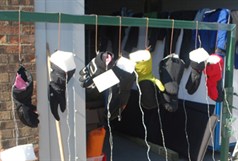 Having run this test it became clear that some more detailed investigation was required, a job carried out by Geoff back in the lab at the University of Portsmouth.
Having run this test it became clear that some more detailed investigation was required, a job carried out by Geoff back in the lab at the University of Portsmouth.
When assessing the gloves it was important to consider the two distinct requirements. The two-man crevasse detection ski team will be spending long periods outside and their hands will mainly be used just operate ski poles. Dexterity is therefore secondary to insulation so large mittens were deemed the best way forward. For the mechanics, however, they will need to be protected whilst performing some detailed tasks. Although they will have a set of outer mittens, they will also have two layers of fingered gloves beneath. For very detailed work they will need to use the inner, or contact, gloves, which will stay on at all times. Even when working on warm engines it could be so easy to place an unprotected hand on a nearby piece of cold metal.
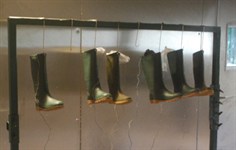 Socks
Socks
The wearer trials for the socks were considered the key factor during the tests. Do they keep your feet dry, do they cause blistering or rubbing etc? The isolated trials were carried for completeness. The system of water liner in a sock alone does not work as the sock just stretches to take up the shape of the bag. The best foot form we found was Wellington boots. Combine the purchase of a stack of these with all the washing up gloves and the local hardware store was doing very well! A few strange looks from the counter staff but that is not unusual.
The water bag/ sock/ Wellington boot and thermocouple assemblies were suspended from rail to avoid any direct conduction pathways.
Wearer Trials
Wearer trials are a mix of assessing both thermal performance and functionality. This is why our chamber subjects were very experienced in working in extreme environments and highly demanding in what they expect from their equipment. They were also not shy on coming forward with opinions.
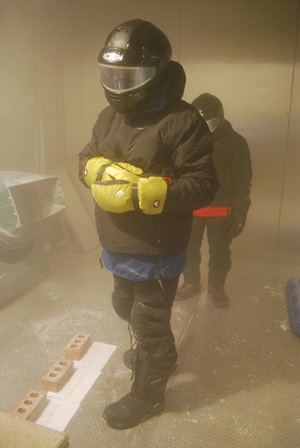 What did we measure?
What did we measure?
The extremities are the first to suffer in the cold, so Geoff wired up Mac and Tomo’s toes and fingers with thermocouples, which were connected to a wireless transmitter sending signals back to a laptop. Being wireless, this system allowed freedom of movement and meant the team did not need to worry about breakages due to the extreme cold, which a wired system would have been susceptible to. At -53C it is amazing how brittle everything becomes.
We had considered core temperature measurements, but in the end dismissed these as a reduction in core temperature lags behind skin temperature and would not have added anything useful to the process. Both test subjects were pleased to hear that core temperature measurement by the ‘traditional means’ was off the agenda, although we didn’t tell the so until the last minute.
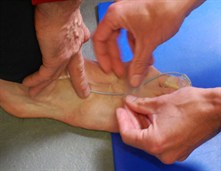 Our assessment regime required periods in which the subjects would perform step ups at a moderate but consistent rate. This was dictated by an audio metronome fitted to Tomo; Mac would just keep in step. To add to the cables and complexity they were also both wearing radios with ear pieces and microphones.
Our assessment regime required periods in which the subjects would perform step ups at a moderate but consistent rate. This was dictated by an audio metronome fitted to Tomo; Mac would just keep in step. To add to the cables and complexity they were also both wearing radios with ear pieces and microphones.
A most important consideration in our wearer trials was that Mac, Tomo and Steven didn’t actually get cold. One might think that would be what you would expect to happen in a cold chamber but for very good scientific reasons we couldn’t allow it. If the temperature in the hands and feet drop below a threshold level then wider changes take place to the circulation within the body that then take a long time to properly reset. To make a valid comparison between clothing systems we needed to be sure that each test cycle started with our subjects in the same condition. For comparison purposes, however, we did not need to run each test to such limits; we only needed to get enough data to differentiate between items A and B. Also, a quicker turnaround allowed us to compare more systems and combinations. A more detailed assessment could take place later in arctic field trials or another session in the chamber.
As well as the skin temperature measurements, our subjects had to complete some perception tests. At specific intervals during each session they would be asked over the radio to score their thermal sensation, thermal comfort and skin wetness off sheets on the chamber floor. These were commented on for both hands and feet.
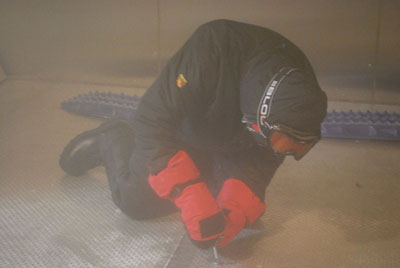 They also had to conduct dexterity tests to see what was achievable with the different glove styles and levels of viewing restriction offered by different helmets and goggles. The dexterity text was a simple one, threading a nut onto a bolt. It was important to get an ambient temperature, ungloved baseline against which we could compare. As soon as it was clear that this was a timed activity, competitive instincts came to the fore. Then add a BBC news camera and it becomes deadly serious.
They also had to conduct dexterity tests to see what was achievable with the different glove styles and levels of viewing restriction offered by different helmets and goggles. The dexterity text was a simple one, threading a nut onto a bolt. It was important to get an ambient temperature, ungloved baseline against which we could compare. As soon as it was clear that this was a timed activity, competitive instincts came to the fore. Then add a BBC news camera and it becomes deadly serious.
After each session in the chamber, typically lasting about 45 minutes, the subjects would step out and present themselves to Geoff and his thermal imaging camera. The camera is especially useful at highlighting cold spots, often along seams where the insulation might be compromised. The camera was also used to record imaged of the hands for each stage of glove removal.
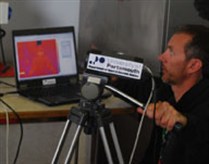 After the thermal camera and with the experience still fresh, the subjects were interviewed by Steve on video camera. This was a quick way of getting a lot of feedback with the tone of voice expressing as much opinion as the words themselves. True to form no one held back in their opinions.
After the thermal camera and with the experience still fresh, the subjects were interviewed by Steve on video camera. This was a quick way of getting a lot of feedback with the tone of voice expressing as much opinion as the words themselves. True to form no one held back in their opinions.
After the interviews, it was time for a quick cup of tea and perhaps a bite to eat before the guys headed back into the chamber with the next combination of clothing and equipment to trial.
Some General Findings
Money isn’t everything and reputations need to be challenged. This was especially the case with some of the gloves we tested. There were a couple of models used extensively in high altitude mountaineering that stunned us with how bad they were; indeed, they were repeat tested just to be sure. Conversely, other gloves showed themselves to be very good and beyond our expectations.
Helmets are good but the demisting of the visors is a challenge. The cold chamber is a very noisy place and so was a good test for quality of radio communications. After the first few tests which featured hoods and goggles we moved onto skidoo helmets with heated visors. The comms immediately became clearer and we knew that helmets would also give us a good platform on which to mount lights and provide protection to the head in crevassed areas or for higher risk activities such as kite skiing. Managing the demisting of the visors and goggles was an ongoing issue in the chamber although further field tests in Sweden did seem to result in a viable solution.
The heated gloves and insoles were a definite benefit but should only be used for keeping a warm person from getting cold. They are not effective in re-warming a cold person’s extremities and indeed working with University of Portsmouth has shown us that warming the hands and feet without warming the rest of the body can be dangerous. Local cellular activity is encouraged but the blood flow to and from the limb is still restricted leading to a build up of toxins in the heated areas.
Conclusion
The chamber trials allowed us to select the equipment for our field trials in Sweden. They highlighted areas for further research both for Sweden and a revisit to the chamber some time nearer the departure date.
